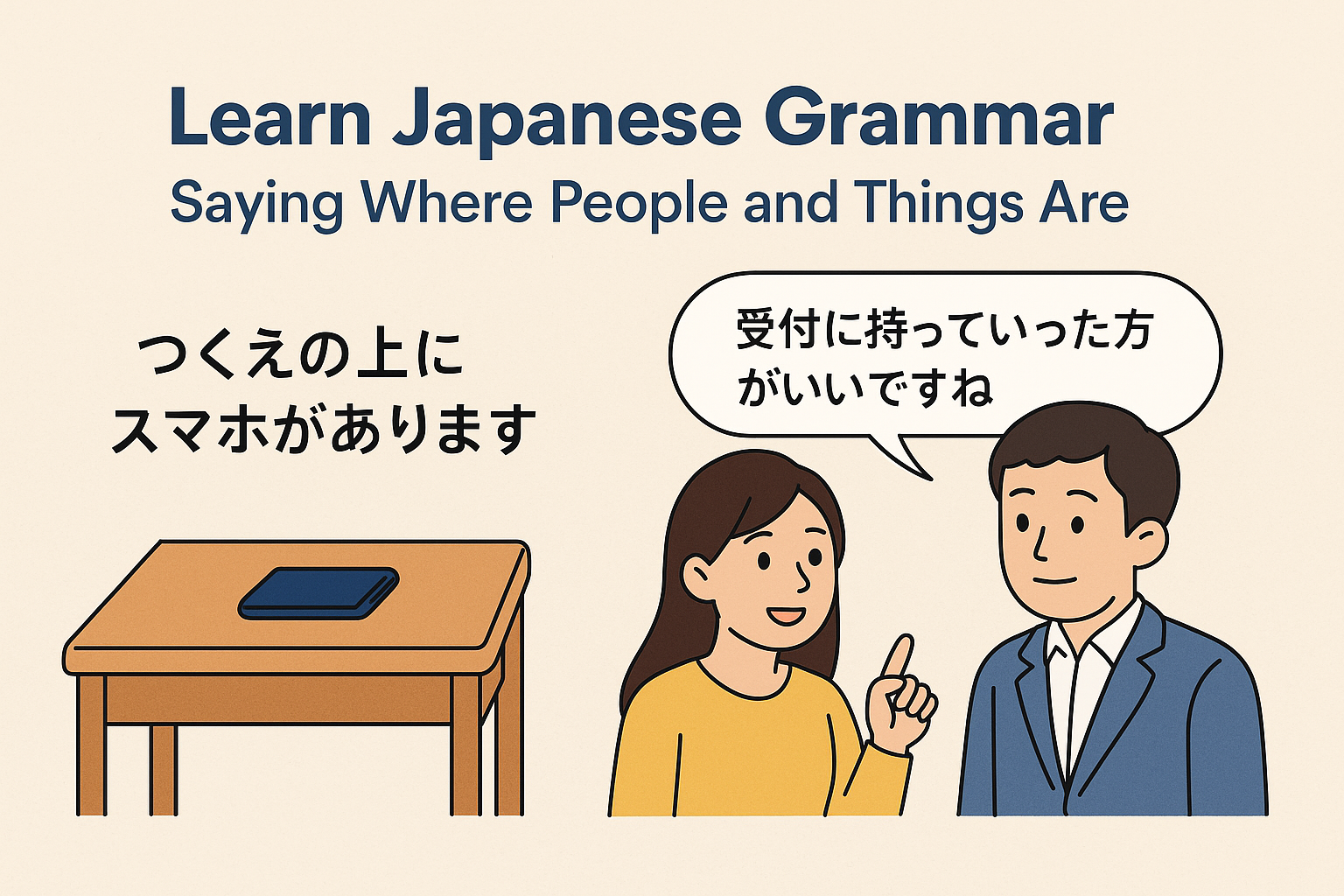場所に物があります/場所に人がいます
Why Learning ‘Arimasu’ and ‘Imasu’ Matters
Hi everyone! How’s your Japanese study going?
Today, I’m going to teach you a useful grammar point: how to say “There is something in a place” or “There is someone in a place” in Japanese.
Once you learn this, you’ll find it really helpful in everyday situations—like when asking for directions, looking for something, or asking if someone is part of a group. It’s a super practical grammar point that you’ll use often!
What is “Arimasu” and “Imasu”
In Japanese, we use the verbs “あります(Arimasu)” and “います(Imasu)” to say that something exists or is present.
We use “あります” for things without life, like objects or plants.
And we use “います” for things with life, like people and animals.
It’s a simple but important rule—just remember:
Non-living = あります, Living = います!
☆Usage Tips!!
Basically, we choose “あります” or “います” depending on whether something is living or not.
But there are exceptions!
For example, robots that act like they have feelings or ghosts that seem to “exist” like a person—these are usually described with “います”, not “あります”.
Even though they’re not technically alive, they feel more like living beings, so Japanese often treats them that way in grammar too.
Sentence Structure: How to Say ‘There Is’ in Japanese
Alright, now let’s look at the sentence structure.
The pattern is:
[Place] + に + [Object/Person] + が + あります / います
There are two important particles to watch out for: “に” and “が”.
For “に”, be careful not to mix it up with other similar particles like “へ” (used for “場所へ動詞”) or “で” (used for “場所で動詞”).
For “が”, make sure you don’t confuse it with “を”, which is used to mark the direct object of an action.
Getting used to these particles can be tricky at first, but with practice, you’ll get the hang of it!
Examples in Daily Life
・つくえの上にスマホがあります。
アンさん:つくえの上にスマホがありますよ。
田中さん:そうですね。だれのでしょうか。
アンさん:受付に持っていった方がいいですね。
・There is a smartphone on the desk.
Ann: There’s a smartphone on the desk.
Tanaka: You’re right. I wonder whose it is.
Ann: We should probably take it to the reception desk.

・そこにだれがいますか。
山田さん:もしもし、リーさんですか。
リーさん:はい。今、会社のみんなと食事しています。
山田さん:そうですか。そこにだれがいますか。
リーさん:田中さんとアンさんがいます。
・Who is there?
Yamada: Hello, is this Lee?
Lee: Yes. I’m having a meal with my coworkers right now.
Yamada: I see. Who is there with you?
Lee: Tanaka and Ann are here.

Mastering Existence Sentences in Japanese
How was it?
There are a few tricky points to watch out for—like when to use あります or います, and how to use the right particles. But once you learn them, this grammar can be super useful in many different situations.
It also often appears in beginner-level tests like the JLPT N5, so it’s definitely worth mastering!
Keep practicing, and you’ll make it your own in no time. You’ve got this!
For Japanese Teachers
This grammar point is relatively easy to explain in terms of meaning, but it comes with several important details that require careful attention.
As mentioned in the article, teachers should emphasize the distinction between “あります” and “います”, as well as the correct use of particles like “に” and “が”.
In addition, there are other points worth noting—for example, when referring to animals, students may mistakenly use the question word “なに” instead of the appropriate one.
It is also important to remind students that this grammar is not used to talk primarily about the place itself, but rather about the existence of people or things in that place.
Another challenge is that sentences using this structure tend to become longer, which can make pronunciation and speaking more difficult for some learners.
To help students get used to the sentence flow, it’s effective to include plenty of conversation-based practice and gradually increase complexity over time.






